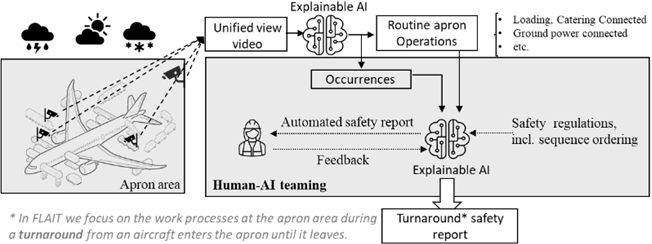
AI AND MACHINE LEARNING
Commercial airlines worldwide are facing huge losses, totalling up to US$ 10.000.000.000, due to aircraft damage that occur when the aircraft is in the apron area (i.e., parked at the gate), and ca. 243 000 people are injured each year in apron-related accidents and incidents [1]. Ground damage to aircraft (e.g., in connection with baggage handling, catering trucks, etc.) is the number one safety issue at airports currently according to the European Union Aviation Safety Agency (EASA) [2] and unreported safety-related occurrences pose the highest risk to flight safety [3].
Occurrences on the apron includes events (e.g., vehicle outside allowed area), incidents (e.g., vehicle collides with safety cone), and accidents (e.g., vehicle collides with airplane). In over one third of the total number of aircraft ground incidents and accidents, the corresponding safety report either lacks critical information or is completely missing [3]. Damages to composite structures (increasingly used for aircraft due to low weight and thus supporting reduced fuel need and the Green Change) tend to be particularly under-reported as such damage can be significant without being visible on the surface [2].
The apron is the busiest area on an airport with strict time-performance goals for the personnel operating there.
Although AI-based (Artificial Intelligence) “assistants” are widely used for applications such as accounting, customer support, etc., airport apron safety reporting still consists mostly of time-consuming and error prone manual procedures.
With the FLAIT project we will pave the way for AI in safety reporting as illustrated in Fig. 1:

Figure 1: The “FLAIT Assistant” with its subsystems incorporate regulations and multiple sensor streams to identify apron occurrences and routine operations.
The FLAIT Assistant will be verified through several demonstrations at an Avinor airport.
In line with the EASA AI Roadmap focus on AI explainability and assurance, the FLAIT Assistant and accompanying guidance and assurance procedures will be designed with Explainable AI such that apron ground personnel and others involved in safety reporting can work with the Assistant as a human-AI team.
Such teaming involves augmenting human capabilities and raising performance beyond that of either entity. Teaming will lead to personnel learning from the FLAIT Assistant in terms of occurrences that the personnel missed during operations, and vice versa (e.g., an occurrence is falsely detected by the FLAIT Assistant).
Sources:
- Flight Safety Foundation
- ACI – Airport Council International
- ACI – Airport Council International
